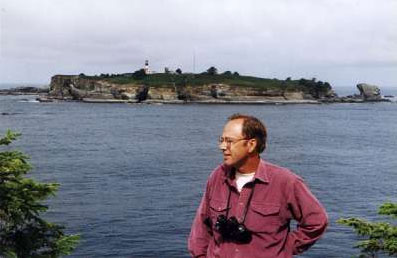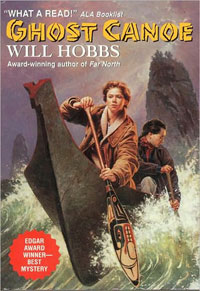 |
I was inspired by a combination of three elements: the native canoes that are once again being carved from cedar trees and paddled on the Pacific; the dramatic cliffs and sea caves out at Cape Flattery, at the tip of the Olympic Peninsula in Washington State; and the lighthouse that sits on tiny Tatoosh Island half a mile out from the Cape. The photo on this page is of me standing on the mainland, on the tip of Cape Flattery, looking out at Tatoosh Island. If you look closely, you can see the lighthouse.
What type of research did the writing of Ghost Canoe involve? Some of my research came before I knew it was research. I hiked around Cape Flattery and I visited the modern Makah town of Neah Bay nearby. I was mesmerized by the Makah's museum, which includes countless artifacts from a Makah village buried by mudslides in the 1400's. There, on display, was their pre-Columbian whaling gear. Looking at those old canoes, tools, cedar boxes, fishing gear, clothing—it all started coming to life for me. I learned that they had hunted the great whales from their canoes well into the twentieth century. Once I started thinking about setting a story in the Makah's home country, I read the history of the lighthouse on Tatoosh, and shipwrecks nearby. I became fascinated with the decade of the 1870s. I learned the history of the Spanish, the British, and the Americans in the Northwest. A dictionary of the Chinook trading jargon was a great find. I read voraciously about the Makahs, who, as you may know from recent news coverage and controversy, have once again begun hunting whales. Of course my story is fictional, but it's based on history that's probably more exciting than anything I could make up! Several of your other novels involve unexplained occurrences, but Ghost Canoe is your first full-fledged mystery. What made you decide to write a mystery? I wanted to try it because so many kids had asked me to write one. A lot of them really like mysteries. I remembered how much I'd liked reading mysteries when I was a kid. The combination of the lighthouse at Tatoosh Island and a shipwreck had “mystery” written all over it. Your deep respect for the culture of native peoples is a hallmark of your work. How has your understanding of these cultures evolved? It has come from a combination of life experience and a lifetime of reading. My wife and I have lived in southwestern Colorado for nearly 40 years, close to the Ute reservations and not far from the Navajo, Zuni and Pueblo people. We worked with Native American kids when we were teachers in the public schools here. I continue to be inspired by the native ideal of living in harmony with nature. I've found ways in some of my novels to include native characters. It started close to home, when I put a Ute boy and an Anglo rancher, both fictional but inspired by people I'd known, together in Bearstone. As I explored distant landscapes, I learned about the traditions of the people we've met there. In Ghost Canoe, readers will learn that people in the Northwest made the lumber for their longhouses by stripping planks from cedar trees, and did so without killing the trees. This is the ultimate in sustainability! We can be inspired by that. I feel that the traditional native ethic is vital to our future. We need to take care of our home, this earth we all share. What would you hope readers experience while reading Ghost Canoe? I want them to live a spine-tingling adventure, one that makes them want to turn the pages. I hope this story will be as exotic and exciting for them as Treasure Island was for me. Note: For more info on the writing of Ghost Canoe, see the Author's Note at the end of the book.
|
|

